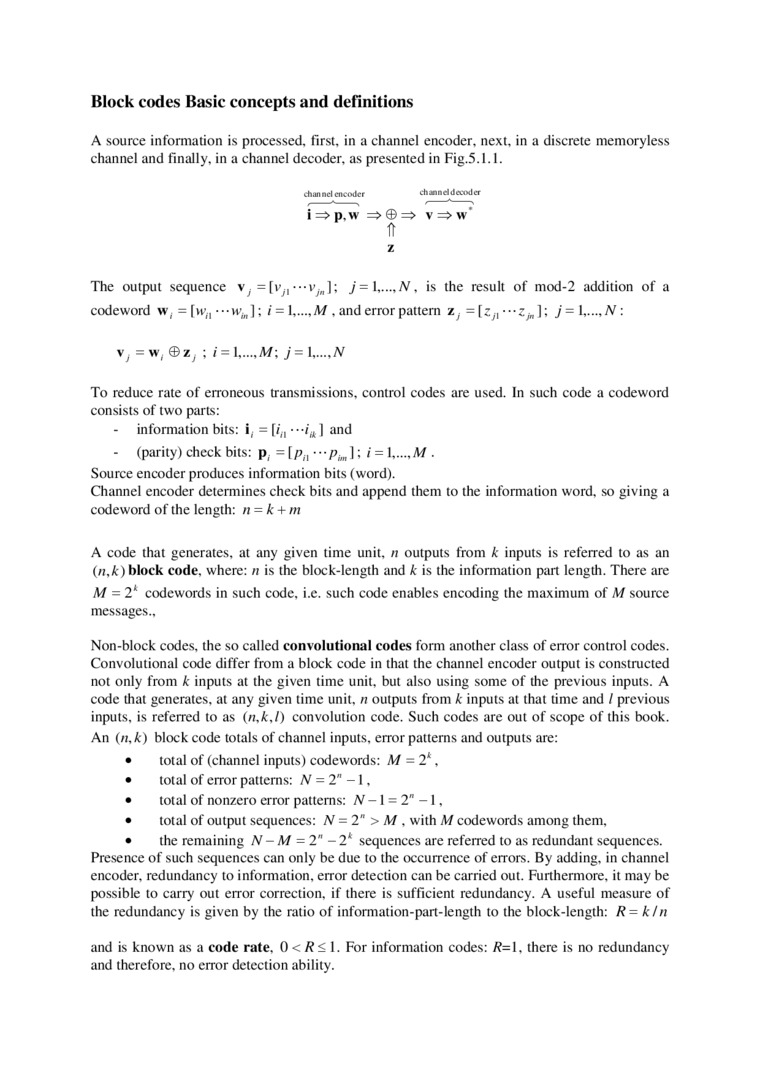66788

Błock codes Basic concepts and dcfinitions
A source information is processed, first, in a channel encoder, next, in a discrele memoryless channel and finally, in a channel decoder, as presented in Fig.5.1.1.
chan nd cncotkr channddtwdtr
i=>p,w =>©=> v =>w z
The output sequence v;. = [vyi j = 1.....N, is the result of niod-2 addition of a
codeword w, = [wn ; i = 1.....M , and error patiem z. = 7 = 1.....N \
\j = w. 0z; ; / = 1,....A/:
To reduce ratę of erroneous transmissions, control codes are used. In such codę a codeword consists of two parts:
informalion bits: i, = [i„ ] and
- (parity) chcck bits: p, =[pn— pm ]; i -1.....M .
Source encoder produces information bits (word).
Channel encoder determines check bits and append them to the information word. so giving a codeword of the length: n = k + m
A codę that generates, at any given time unit, n outputs from k inputs is referred to as an (n,k) błock codę. where: n is the block-length and k is the information part length. There are
M = 2* codewords in such codę, i.e. such codę enables cncoding the maximum of M source messages..
Non-block codes, the so called convolutional codes form another class of error control codes. Convolutional codę differ from a błock codę in that the channel encoder output is constructed not only from k inputs at the given limę unit. but also using some of the previous inputs. A codę that generates. at any givcn time unit. n outputs from k inputs at that time and / prcvious inputs, is referred to as (n,k,l) convolution codę. Such codes are out of scope of this book. An (//, k) błock codę totals of channel inputs, error pattems and outputs are:
• total of (channel inputs) codewords: M = 2*,
• total of error pattems: N = 2" -1,
• total of nonzero error pattems: AT -1 = 2" -1,
• total of output sequences: N = 2" > M . with M codewords among them,
• the remaining N - M = 2" - 2* sequences are referred to as redundant sequences. Presence of such sequences can only be due to the occurrence of errors. By adding, in channel encoder, redundancy to information, error detection can be carried out. Furthermore, it may be possible to carry out error correction. if there is sufficient redundancy. A usefui measure of the redundancy is given by the ratio of information-part-length to the block-length: R= kin
and is known as a codę ratę. 0 < R< 1. For information codes: R= 1. there is no redundancy and therefore. no error detection ability.
Wyszukiwarka
Podobne podstrony:
ment systems, i.e. CAM and/or CIM, which are op-erated in the production company. After information
INFORMACJA 270 WN24 320 Discovery Channel 367 Next Man HD 271 TVN24 HD 321 Discovery Channel
Codes and codę converters Coding is an action of assigning some symbols to different information. Th
K_U01 The student can obtain information from literaturę, databases and other sources, in English or
A.L. Kroeber i C. Kluckhohn w rozprawie Culture. A Critical Review of Concepts and Definitions przep
sub/ ■ ic- is-a super is-a / / super Basic Concepł (as
la personnalite des acteurs, les conditions techniąues et les sources d informadon, la manierę dont
44 A. EJCHART PIŚMIENNICTWO CYTOWANE [1] H. Friebolin, Basic One- and Two-Dimensio
Appendix EAnswers to Review Questions updatcs: 1/2,06:6.6. “81 Basic Conceptsl.l Welcome lo Assembly
-0.8 -0.6 Physics init Element Thermal properties and heat sources/sinks Library
15ddg05 Available References: H Visual B asie For Applications ^ E Visual Basic ob
GrapesJS Free and Open source Web Template Editor Ncxł Rcncratłon tool for bollding tcmplatM without
więcej podobnych podstron